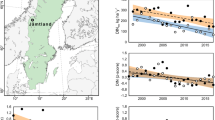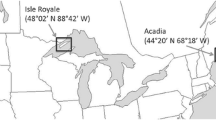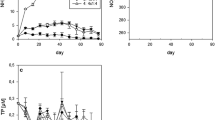Abstract
Phosphorus has been traditionally regarded as the controlling nutrient for phytoplankton growth, however, N-limitation is likely to occur in several environments. For example, nitrogen is considered the main nutrient limiting phytoplankton in floodplain lakes of the Paraná River basin. However, N2-fixing heterocystous cyanobacteria (N2-cyano) are usually absent in these water bodies. The low pH values frequently found may limit the development of these algae. We hypothesise that long-term lake isolation allows conspicuous phytoplankton growth during summer, resulting in high photosynthetic rates and pH. This scenario combined with low DIN (dissolved inorganic nitrogen) would favour the development of N2-cyano. Phytoplankton composition was studied during 16 months in a vegetated and isolated floodplain lake in the Paraná basin. Additionally, pH was artificially increased in in situ mesocosms to test effects on phytoplankton structure. Lake phytoplankton was dominated by flagellates (cryptophytes and euglenophytes) and small coccoid algae (chlorophytes and colonial cyanobacteria). Algal biomass was highest during warm periods. Although pH increased up to 8.8 during the second summer period, N2-cyano remained rare, most likely because of the high DIN concentration recorded. The alkalophilic diatom Cyclotella meneghiniana dominated and was positively correlated with pH. Conversely, PO =4 concentrations in the mesocosm experiment were high and DIN remained relatively low. pH enhancement in the treated mesocosms (avg. pH = 8.2) promoted the development of N2-cyano (Anabaena spp.) and C. meneghiniana, which after 1 month of incubation accounted together for 50% of the biomass in contrast to less than 1.6% in control containers. Our results support the hypothesis that during the warm season and under low DIN concentration, high pH favours N2-cyano growth in these lakes. We provide new evidence supporting the idea that even under optimal nutrient conditions, N2-cyano do not thrive unless other requirements are satisfied.









Similar content being viewed by others
References
APHA (American Public Health Association) (1998) Standard methods for the examination of water and wastewater, 20th edn. APHA, Washington, DC, p 1268
Bader KP, Roëben A (1995) Mass-spectrometric detection and analysis of nitrogen fixation in Oscillatoria chalybea. Zeitschrift für Naturforschung 50:199–204
Beardall J (1985) Occurrence and importance of HCO3 − utilization in microscopic algae. In: Lucas W, Berry JA (eds) Inorganic carbon uptake by aquatic photosynthetic organisms, Amer. Soc. Plant Physyologists. Waverly Press, Rockville, pp 83–96
Bergman B, Gallon JR, Rai AN, Stal LJ (1997) N2 Fixation by non-heterocystous cyanobacteria. FEMS Microbiol Rev 19:139–185
Bonetto C, de Cabo L, Gabellone N, Vinocur A, Donadelli J, Unrein F (1994) Nutrient dynamics in the deltaic floodplain of the Lower Paraná River. Arch Hydrobiol 131(3):277–295
Caraco NF, Miller R (1998) Effects of CO2 on competition between a cyanobacterium and eukaryotic phytoplankton. Can J Fish Aquat Sci 55:54–62
Carignan R, Neiff JJ (1992) Nutrient dynamics in the floodplain ponds of the Paraná River (Argentina) dominated by the water hyacinth Eichhornia crassipes. Biogeochemistry 17:85–121
Carignan R, Planas D (1994) Recognition of nutrient and light limitation in turbid mixed layers: three approaches compared in the Paraná floodplain (Argentina). Limnol Oceanogr 39(3):580–596
Carignan R, Neiff JJ, Planas D (1994) Limitation of water hyacinth by nitrogen in subtropical lakes of the Paraná floodplain (Argentina). Limnol Oceanogr 39(2):439–443
de Tezanos Pinto P, Allende L, O’Farrell I (2007) Influence of free-floating plants on the structure of a natural phytoplankton assemblage: an experimental approach. J Plank Res 29:47–56
Dokulil MT (1988) Seasonal and spatial distribution of cryptophycean species in the deep, stratifying, alpine lake Mondsee and their role in the food web. Hydrobiologia 161:185–201
Dzialowski AR, Wang S-H, Lim N-C, Spotts WW, Huggins DG (2005) Nutrient limitation of phytoplankton growth in central plains reservoirs, USA. J Plankton Res 27:587–595
Elser JJ, Marzolf ER, Goldman CR (1990) Phosphorus and nitrogen limitation of phytoplankton growth in the freshwaters of North America: a review and critique of experimental enrichments. Can J Fish Aquat Sci 47:1468–1477
Engle DL, Melack JM (1993) Consequences of riverine floodplain for seston and the periphyton of floating meadows in an Amazon floodplain lake. Limnol Oceanogr 38(7):1500–1520
Ferber LR, Levine SN, Lini A, Livingston GP (2004) Do cyanobacteria dominate in eutrophic lakes because they fix atmospheric nitrogen? Freshw Biol 49:690–708
Forsberg BR, Devol AH, Richey JE, Martinelli LA, dos Santos H (1988) Factors controlling nutrient concentrations in Amazon floodplain lakes. Limnol Oceanogr 33(1):41–56
García de Emiliani MO (1981) Fitoplancton de una laguna del valle aluvial del Paraná Medio (“Los Matadores”, Santa Fe, Argentina). II: Factores ecológicos asociados a la distribución de las especies. Ecología 6:73–77
García de Emiliani MO (1990) Phytoplankton ecology of the Middle Paraná River. Acta Limnol Brasil 3:391–417
García de Emiliani MO (1993) Seasonal succession of phytoplankton in a lake of the Paraná River floodplain, Argentina. Hydrobiologia 264:101–114
García de Emiliani MO (1997) Effects of water level fluctuations on phytoplankton in a river-floodplain lake system (Paraná River, Argentina). Hydrobiologia 357:1–15
Hamilton SK, Lewis WM (1987) Causes of seasonality in the chemistry of a lake on the Orinoco River floodplain, Venezuela. Limnol Oceanogr 32(6):1277–1290
Hense I, Beckmann A (2006) Towards a model of cyanobacteia life cycle-effects of growing and resting stages on bloom formation of N2-fixing species. Ecol Modell 195:205–218
Hillebrand H, Durselen C-D, Kirshtel D, Pollingher U, Zohary T (1999) Biovolume calculation for pelagic and benthic microalgae. J Phycol 35:403–424
Howarth RW, Marino R, Lane J, Cole JJ (1988) Nitrogen fixation in freshwater, estuarine, and marine ecosystems. 1. Rates and importance. Limnol Oceanogr 33(4):669–687
Imai A, Fukushima T, Matsushige K (1999) Effects of iron limitation and aquatic humic substances on the growth of Microcystis aeruginosa. Can J Fish Aquat 56:1929–1937
Izaguirre I, O’Farrell I, Unrein F, Sinistro R, dos Santos Afonso M, Tell G (2004) Algal assemblages across a wetland, from a shallow lake to relictual oxbow lakes (Lower Paraná River, South America). Hydrobiologia 511:25–36
Jensen JP, Jeppesen E, Olrik K, Kristensen P (1994) Impact of nutrients and physical factors on the shift from cyanobacterial to chlorophyte dominance in shallow Danish lakes. Can J Fish Aquat Sci 51:1692–1699
Klaveness D (1988) Ecology of the Cryptomonadida: a first review. In: Sandgren CD (ed) Growth and reproductive strategies of freshwater phytoplankton. Cambridge University Press, New York, pp 105–133
Knowlton MF, Jones JR (1995) Experimental evidence of light and nutrient limitation of algal growth in a turbid Midwest reservoir. Arch Hydrobiol 135:321–335
Knowlton MF, Jones JR (1997) Trophic status of Missouri River floodplain lakes in relation to basin type and connectivity. Wetlands 17(4):468–475
Koroleff F (1983) Simultaneous oxidation of nitrogen and phosphorus compounds by persulfate. In: Grosshoff K, Eberhodt M, Kremling K (eds) Methods of seawater analysis. Verlag Chemie, Wainheimer, pp 168–169
Kronberg L (1999) Content of humic substances in freshwater. In: Eloranta JKP (ed) Limnology of humic waters. Backhuys Publishers, Leiden, pp 9–10
Lewis WM Jr, Wurtsbaugh WA (2008) Control of lacustrine phytoplankton by nutrients: erosion of the phosphorus paradigm. Internat Revue Hydrobiol 93:446–465
Maberly SC, King L, Dent MM, Jones RI, Gibson CE (2002) Nutrient limitation of phytoplankton and periphyton growth in upland lakes. Freshw Biol 47:2136–2152
Needoba JA, Foster RA, Sakamoto C, Zehr JP, Johnson KS (2007) Nitrogen fixation by unicellular diazotrophic cyanobacteria in the temperate oligotrophic North Pacific Ocean. Limnol Oceanogr 52(4):1317–1327
O’Farrell I, Sinistro R, Izaguirre I, Unrein F (2003) Do steady state assemblages occur in shallow lentic environments from wetlands? Hydrobiologia 502:197–209
O’Farrell I, de Tezanos Pinto P, Rodríguez P, Chaparro G, Pizarro H (2009) Experimental evidence of the dynamic effect of free-floating plants on phytoplankton ecology. Freshw Biol 54:363–375
Oliver RL, Ganf GG (2000) Freshwater blooms. In: Whitton BA, Potts M (eds) The ecology of cyanobacteria. The diversity in time and space. Kluwer, Dordrecht, pp 149–194
Ortega-Mayagoitia E, Rojo C, Rodrigo MA (2003) Controlling factors of phytoplankton taxonomic structure in wetlands: an experimental approach. Hydrobiologia 502:177–186
Pedrozo F, Diaz M, Bonetto C (1992) Nitrogen and phosphorus in the Parana River waterbodies. Arch Hydrobiol 2:171–185
Pithart D (1999) Phytoplankton and water chemistry of several alluvial pools and oxbows after the flood event—a process of diversification. Algol Stud 95:93–113
Price GD, Badger MR, Woodger FJ, Long BM (2008) Advances in understanding the cyanobacterial CO2-concentrating-mechanism (CCM): functional components, Ci transporters, diversity, genetic regulation and prospects for engineering into plants. J Exp Bot 59:1441–1461
Raven JA (1985) The CO2 concentrating mechanism. In: Lucas W, Berry JA (eds) Inorganic carbon uptake by aquatic photosynthetic organisms, Amer. Soc. Plant Physyologists. Waverly Press, Rockville, pp 67–82
Reynolds CS (2006) The ecology of phytoplankton. Cambridge University Press, Cambridge, p 535
Rodríguez P (2008) Estructura y producción primaria del fitoplancton y perifiton en un humedal del Bajo Paraná. PhD thesis, University of Buenos Aires, Buenos Aires, p 264
Rodriguez P, Pizarro H (2007) Phytoplankton productivity in a highly colored shallow lake of a South American floodplain. Wetlands 27(4):1153–1160
Scheffer M (1998) Ecology of shallow lakes. Chapman & Hall, London, p 357
Shapiro J (1973) Blue-green algae: why they become dominant. Science 179:382–384
Shapiro J (1990) Current beliefs regarding dominance by blue-greens: the case for the importance of CO2 and pH. Verh Internat Verein Limnol 24:38–54
Shapiro J (1997) The role of carbon dioxide in the initiation and maintenance of blue-green dominance in lakes. Freshw Biol 37:307–323
Sinistro R, Izaguirre I, Asikian V (2006) Experimental study on the microbial plankton community in a South American wetland (Lower Paraná River Basin), and the effect of the light deficiency due to the floating macrophytes. J Plank Res 28(8):753–768
Staal M, Hekkert SL, Brummer GL, Veldhuis M, Sikkens C, Persijn S, Stal L (2007) Nitrogen fixation along a north–south transect in the eastern Atlantic Ocean. Limnol Oceanogr 52(4):1305–1316
Stewart AJ, Wetzel RG (1986) Cryptophytes and other microflagellates as couplers in planktonic community dynamics. Arch Hydrobiol 106(1):1–19
Stumm W, Morgan JJ (1981) Aquatic chemistry. Willey-Interscience Publication, New York, p 780
Unrein F (2001) Efecto de los nutrients y el pH sobre el crecimiento y la estructura del fitoplancton en ambientes de la llanura alluvial del Paraná Inferior. PhD thesis, University of Buenos Aires, Buenos Aires, p 162
Unrein F (2002) Changes in phytoplankton community along a transversal section of the Lower Paraná floodplain, Argentina. Hydrobiologia 468(1–3):123–134
Unrein F, Tell G (1994) Respuesta del fitoplancton al enriquecimiento con fósforo y nitrógeno en aguas de una laguna de inundación del río Paraná. Rev Hydrobiol Trop 27(4):315–328
Utermöhl H (1958) Zur vervollkommnung der quantitativen Phytopankton Methodik. Mitteilungen Internationale Vereinigung Limnologie 9:1–38
Van Dam H, Merters A, Sinkeldam J (1994) A coded checklist and ecological indicator values of freshwater diatoms from the Netherlands. Neth J Aquat Ecol 28(1):117–133
Venrick EL (1978) How many cells to count? In: Sournia A (ed) Phytoplankton manual. UNESCO Press, Paris, pp 167–180
Villar CA, de Cabo L, Vaithiyanathan P, Bonetto C (1998) River–floodplain interactions: nutrient concentration in the Lower Paraná River. Arch Hydrobiol 142(4):433–450
Wiedner C, Nixdorf B (1998) Success of chrysophytes, cryptophytes and dinoflagellates over blue-greens (cyanobacteria) during an extreme winter (1995/96) in eutrophic shallow lakes. Hydrobiologia 369(370):229–235
Zalocar de Domitrovic Y (1990) Efecto de las fluctuaciones del nivel hidrométrico sobre el fitoplancton en tres lagunas isleñas en el área de la confluencia de los ríos Paraná y Paraguay. Ecosur 16(27):13–29
Zalocar de Domitrovic Y (1992) Fitoplancton de ambientes inundables del río Paraná (Argentina). Rev Hydrobiol Trop 25(3):177–188
Zalocar de Domitrovic Y (1993) Fitoplancton de una laguna vegetada por Eichhornia crassipes en el valle de inundación del río Paraná (Argentina). Ambiente Subtrop 3:39–67
Zalocar de Domitrovic Y (2000) Estructura y dinámica del fitoplancton en la cuenca del eje potámico Paraguay-Paraná (Argentina). PhD thesis, Universidad Nacional de Córdoba, Córdoba, p 371
Zalocar de Domitrovic Y (2003) Effect of fluctuations in water level on phytoplankton development in three lakes of the Paraná River Floodplain (Argentina). Hydrobiologia 510:175–193
Zehr JP, Waterbury JB, Turner PJ, Montoya JP, Omoregie E, Steward GF, Hansen A, Karl DM (2001) Unicellular cyanobacteria fix N2 in the subtropical North Pacific Ocean. Nature 412:635–638
Zehr JP, Jenkins BD, Short SM, Steward GF (2003) Nitrogenase gene diversity and microbial community structure: a cross-system comparison. Environ Microbiol 5(7):539–554
Acknowledgments
We thank the staff of the Otamendi Reserve (Parques Nacionales), R. Lombardo, D. Medesani, Sara, M. E. Alemanni, A. Podlejski and E. Uliana for their assistance in the field and INTA-Delta for supply the water level of the Paraná River and the precipitation data. This work was supported by CONICET, UBA and ANCYPT (Argentina).
Author information
Authors and Affiliations
Corresponding author
Rights and permissions
About this article
Cite this article
Unrein, F., O’Farrell, I., Izaguirre, I. et al. Phytoplankton response to pH rise in a N-limited floodplain lake: relevance of N2-fixing heterocystous cyanobacteria. Aquat. Sci. 72, 179–190 (2010). https://doi.org/10.1007/s00027-009-0115-1
Received:
Accepted:
Published:
Issue Date:
DOI: https://doi.org/10.1007/s00027-009-0115-1




